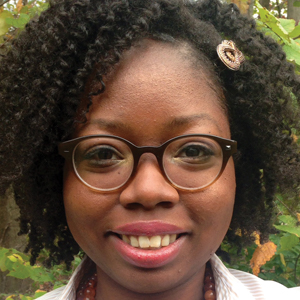'Anywhere you go, be ready to review your work'
Maria Grandoni talked to ASBMB Today about her experience first working as a scientist in manufacturing at MilliporeSigma and now in quality control at PPD, part of Thermo Fisher Scientific. She offered advice for people interested in industry careers. This interview has been condensed and edited.

Current position: Scientist with PPD clinical reseach business
Education: Bachelor’s in biochemistry, Worcester Polytechnic Institute
First job outside of academia: Associate production scientist at MilliporeSigma
Favorite molecule or protein: Prions. “I don't know if that counts. Out here in Wisconsin, we have an issue. We've always had issues with wasting disease with deer. It's really sad. I remember in high school when that was first brought to our attention and everyone was asking questions: What do we know about it? How can we stop it?”
How did you get started in the industry?
When I was in college, I was a biochemistry major. There were different technologies being used for biochemistry, and one of them was high-performance liquid chromatography. That was something specific I have always been interested in.
I worked in chemical manufacturing with MilliporeSigma for a couple of years. After a time, I realized it wasn't something I genuinely liked. I started looking again, and the PPD clinical research business of Thermo Fisher was was describing its testing methods, and HPLC and Western blots came up. They seemed like both really good options.
Can you tell me about your work at MilliporeSigma?
MilliporeSigma is a really big company, and the group I was with was making large amounts of potent material. It was drug manufacturing. I like to say, "In large amounts they cause cancer, and in small amounts they cure cancer." That was where I was using the methods.
What do you do at PPD?
I'm in quality control. I'm on the stability team for a client. They’re making sure that these compounds at certain time points — whether it's three months, nine months, two years — are still meeting their specification criteria.
I'm specifically with the HPLC group. I do all kinds — like size exclusion, anion-exchange and reverse phase — for the client to determine if these compounds are still usable.
What does a typical day look like?
We have our assignments given to us by the project manager, who is in communication with our client. Our group lead separates the testing for who goes where. I talk with my supervisor about what I have been given and the expected time to do it. Because HPLC requires mobile phases, it's a lot of communication, not only with my supervisor but with other people I'm working with.
I try to always have my testing planned at least a week in advance. And if I have a free day, when I'm not actually doing testing and I'm not making solutions, I'm usually figuring out that future testing and making sure I have everything I need.
What advice would you give to someone who is interested in a similar career path?
Learn about good manufacturing practice. I didn't know about it going into manufacturing. It definitely looks better to those considering hiring you that you have maybe not background but an understanding of what it is. It's everywhere, especially in commercial use. < p/>
In manufacturing, it's like you read the step, you do the step. That's all you have to do. I worked the graveyard shift, so we had less support in case something went wrong. You have to be incredibly focused on detail because, if you miss anything, like one small sentence, that could cause the whole process to come to a halt. There could be an impact to the chemical reaction that's happening. Anywhere you go, be ready to review your work.
If you're stressed, you need to step back and take care of yourself. Working this quality control, where the data is going to a drug that potentially may be used for people, there is a lot of pressure. If you feel overwhelmed, don't think that you're not capable. You just need to understand that it takes time, and you will get it.
Enjoy reading ASBMB Today?
Become a member to receive the print edition four times a year and the digital edition monthly.
Learn moreFeatured jobs
from the ASBMB career center
Get the latest from ASBMB Today
Enter your email address, and we’ll send you a weekly email with recent articles, interviews and more.
Latest in Careers
Careers highlights or most popular articles

Sketching, scribbling and scicomm
Graduate student Ari Paiz describes how her love of science and art blend to make her an effective science communicator.

Embrace your neurodivergence and flourish in college
This guide offers practical advice on setting yourself up for success — learn how to leverage campus resources, work with professors and embrace your strengths.

Upcoming opportunities
Apply for the ASBMB Interactive Mentoring Activities for Grantsmanship Enhancement grant writing workshop by April 15.

Quieting the static: Building inclusive STEM classrooms
Christin Monroe, an assistant professor of chemistry at Landmark College, offers practical tips to help educators make their classrooms more accessible to neurodivergent scientists.

Unraveling oncogenesis: What makes cancer tick?
Learn about the ASBMB 2025 symposium on oncogenic hubs: chromatin regulatory and transcriptional complexes in cancer.

Exploring lipid metabolism: A journey through time and innovation
Recent lipid metabolism research has unveiled critical insights into lipid–protein interactions, offering potential therapeutic targets for metabolic and neurodegenerative diseases. Check out the latest in lipid science at the ASBMB annual meeting.

